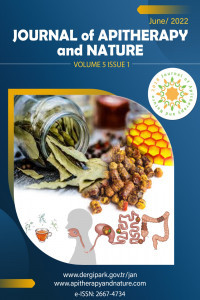Phenolic composition of Pine (Pinus spp.) honey from Turkey
Phenolic composition of Pine (Pinus spp.) honey from Turkey
In this study, the phenolic components of pine honey, which is a secretion honey, were studied. Total polyphenol content and total flavanoid contents of the honeys were ranged from 30 to 52 mg GAE/100 g and 0,86 to 1,58 mg QE/100 g, respectively. The phenolic composition of the honeys were analyzed by HPLC-UV assay with C18 column. The honey was found to be rich in protocathuic acid, chrysin, caffeic acid phenyl ester, p-OH benzoic acid, catechine, luteolin and gallic acid.
___
- Bahramsoltani, R., Ebrahimi, F., Farzaei, M. H., Baratpourmoghaddam, A., Ahmadi, P., Rostamiasrabadi, P., ... & Rahimi, R. (2019). Dietary polyphenols for atherosclerosis: A comprehensive review and future perspectives. Critical reviews in food science and nutrition, 59(1), 114-132.
- Bogdanov, S., Lüllmann, C., Martin, P., von der Ohe, W., Russmann, H., Vorwohl, G., ... & Flamini, C. (1999). Honey quality and international regulatory standards: review by the International Honey Commission. Bee world, 80(2), 61-69.
- Can, Z., Baltaş, N., Keskin, S., Yıldız, O., & Kolaylı, S. (2017). Properties of antioxidant and anti-inflammatory activity and phenolic profiles of Şevketi Bostan (Cnicus benedictus L.) cultivated in Aegean Region from Turkey. Turkish Journal of Agriculture-Food Science and Technology, 5(4), 308-314.
- Can, Z., Yildiz, O., Sahin, H., Turumtay, E. A., Silici, S., & Kolayli, S. (2015). An investigation of Turkish honeys: their physico-chemical properties, antioxidant capacities and phenolic profiles. Food Chemistry, 180, 133-141.
- Çakır, H. E., Şirin, Y., Kolaylı, S., & Zehra, C. A. N. (2018). Validation methods for phenolic components with RP-HPLC-UV in various bee products. Apiterapi ve Doğa Dergisi, 1(1), 13-19.
- Dinkov, D. (2003). A scientific note on the specific optical rotation of three honey types from Bulgaria. Apidologie, 34(3), 319-320.
- Ertürk, Ö., Şahin, H., Kolaylı, S., & Ayvaz, M. Ç. (2014). Antioxidant and antimicrobial activity of East Black Sea Region honeys. Turkish Journal of Biochemistry/Turk Biyokimya Dergisi, 39(1).
- Fukumoto, L. R., & Mazza, G. (2000). Assessing antioxidant and prooxidant activities of phenolic compounds. Journal of agricultural and food chemistry, 48(8), 3597-3604.
- Joseph, S. V., Edirisinghe, I., & Burton-Freeman, B. M. (2016). Fruit polyphenols: A review of anti-inflammatory effects in humans. Critical reviews in food science and nutrition, 56(3), 419-444.
- Kaygusuz, H., Tezcan, F., Erim, F. B., Yildiz, O., Sahin, H., Can, Z., & Kolayli, S. (2016). Characterization of Anatolian honeys based on minerals, bioactive components and principal component analysis. LWT-Food Science and Technology, 68, 273-279.
- Kim, K. H., Tsao, R., Yang, R., & Cui, S. W. (2006). Phenolic acid profiles and antioxidant activities of wheat bran extracts and the effect of hydrolysis conditions. Food Chemistry, 95(3), 466-473.
- Kolaylı, S., Baltas, N., Sahin, H., & Karaoglu, S. (2017). Evaluation of anti-Helicobacter pylori activity and urease inhibition by some Turkish authentic honeys. JFSE, 7, 67-73.
- Kolayli, S., Can, Z., Çakir, H. E., Okan, O. T., & Yildiz, O. (2018). An investigation on Trakya region Oak (Quercus spp.) honeys of Turkey: Their physico-chemical, antioxidant and phenolic compounds properties. Turkish Journal of Biochemistry, 43(4), 362-374.
- Malkoç, M., Çakır, H., Yakup, K. A. R. A., Zehra, C. A. N., & Kolaylı, S. (2019b). Phenolic composition and antioxidant properties of Anzer honey from black sea region of Turkey. Uludağ Arıcılık Dergisi, 19(2), 143-151.
- Malkoç, M., Yakup, K. A. R. A., Özkök, A., Ertürk, Ö., & Kolaylı, S. (2019a). Karaçalı (Paliurus Spina-Christi Mill.) Balının Karakteristik Özellikleri. Uludağ Arıcılık Dergisi, 19(1), 69-81.
- Özkök, D., & Silici, S. (2017). Antioxidant activities of honeybee products and their mixtures. Food science and biotechnology, 26(1), 201-206.
- Serrano, S., Rodríguez, I., Moreno, R., & Rincón, F. (2019). Detection of key factors affecting specific optical rotation determination in honey. CyTA-Journal of Food, 17(1), 574-580.
- Singleton, V. L., Orthofer, R., & Lamuela-Raventós, R. M. (1999). [14] Analysis of total phenols and other oxidation substrates and antioxidants by means of folin-ciocalteu reagent. In Methods in enzymology (Vol. 299, pp. 152-178). Academic press.
- Kara, Y., Can, Z., & Kolaylı, S. (2019). HPLC analyses of polyphenolic compounds in oak (Querces frainetto) honey from Kırklareli region of Turkey. Turkish Journal of Analytical Chemistry, 1.
- Yayın Aralığı: Yılda 2 Sayı
- Başlangıç: 2018
- Yayıncı: Oktay YILDIZ
Sayıdaki Diğer Makaleler
Royal Jelly: Proteins and Peptides
The Presence and Distribution of Nosemosis Disease in Turkey
Onur TOSUN, Çağrı BEKİRCAN, Hilal BAKİ
Antioxidant Capacity of a Bee Pollen Sample Obtained from Giresun, Turkey
Phenolic composition of Pine (Pinus spp.) honey from Turkey
Ayşegül ÖZER, Erva RAKICI, Kadriye INAN BEKTAS, Sabriye ÇANAKÇI, Ali Osman BELDUZ
